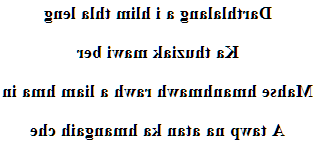Lushai love poem
Darthlalang
Darthlalang a i hlim thla leng
Ka thuziak mawi ber
Mahse hmanhmawh rawh a liam hma in
A tawp na atan ka hmangaih che


→ French poem ←
Lushai language
Love poem into Lushai language (other names that can be found : Mizo, Lushai-Mizo, Lukhai, Lusago, Lusai, Mizoṭawng, Lusei, Kookis, Lushei, Mizo ṭawng, Mizo Chin, Duhlian Twang, Dulien, Fannai, Hualngo, Tlau, Whelngo, Le, Lei, Ngente, Sailau).
This tibeto-Burmese tonal language of the central subgroup of the Kukish (Kuki-Chin) branch, is spoken by the Lushais (Mizo) 700,000 speakers in India in Mizoram (Lushai hills, southern Manipur, Tripura and Cachar Hills) , Bangladesh, and Burma (the Chin Hills).
There are several dialects, variants that are specific to different clans, separated by a mountainous geography.
Before the arrival of the British, it was the Dulien dialect that was imposed as the lingua franca of Mizoram, because the Sailo chiefs were those who knew how to unify all the clans.
Originally, they probably used the same idiom which evolved differently. In fact, their culture truly reunites them: all the clans share a rich oral tradition, and all of them tell each other the same poetic songs, the same myths, tales and legends.
They write their language with the Latin alphabet.
The Mizos
The Mizos (Lushais) are of Tibetan-Burmese origin, their ethnicity is probably from a Chin group, who have settled in the Mizoram mountains.
In fact their origin is uncertain, contested and sometimes romantic. For some, the name Chin given by the Burmese suggests that they came from China (a legend says that they were part of the workers of the Great Wall, having fled to escape their fate).
For others, they would have been born in a cave, for still others their origin would be Himalayan, in any case, it seems attested that their origin is Mongoloid.
The Mizos originally were semi-nomads, who surely have to move a lot to find a territory. They practice the culture on burning and form a patrilineal society, where polygamy remains reserved to the aristocracy.
The Lushais depending the regions where they lived were referred to by different names reflecting clans: Lushais, Lusei, Lai, Hmar, Mara, Dzos, Chins, Kukis, Mizos, Zos, Zomis, Sailo, Paite, Ralte, Fanai.
It should be noted that often these names eg Chin, Lushai are the names of the hills where they live. In 1954, the Lushai Hills were renamed Mizo ("mi" = person, "zo" = mountain), and later Mizoram.
For the word lushai (Lusei), it means "long head" which would be the name of their common ancestor, for others "lu" = head, "sha" = cut, and therefore means "head cutter", which fits quite well with this tradition that their ancestors had.
Mizoram (North-East India) has been detached from Assam since 1972. Its population is made up of tribes of various origins. It is also in this state that we find the highest tribal concentration of India.
Chakma poem